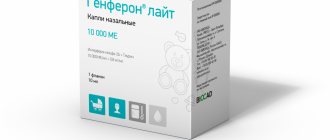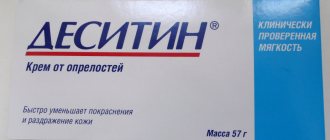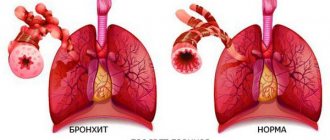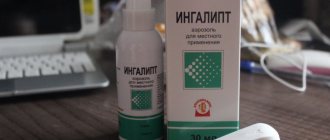Composition per 1 ml
Active substance: xylometazoline hydrochloride – 0.50 mg or 1.00 mg; Excipients: disodium edetate (Trilon B) – 0.50 mg, sodium chloride – 9.00 mg, benzalkonium chloride – 0.15 mg, potassium dihydrogen phosphate – 3.63 mg, sodium hydrogen phosphate dodecahydrate – 7.13 mg, purified water – up to 1 ml.
Description: transparent, colorless or slightly colored liquid.
Pharmacotherapeutic group: anticongestive agent – alpha-adrenergic agonist.
ATX code : R01AA07
What Rinostop contains
The main active component of the drug is xylometazoline hydrochloride. This substance belongs to alpha-adrenergic agonists; when applied topically, it causes a reflex vasoconstriction.
Rinostop is produced in the form of:
- nasal spray: in bottles with a dispenser spray with a capacity of 10–30 ml, with a concentration of 0.1 and 0.05% of the active substance;
- nasal drops: similar volume and concentration in bottles with a drip dispenser.
Among the auxiliary components of the product: distilled water and stabilizing additives.
Contraindications
Hypersensitivity to xylometazoline and other components of the drug, arterial hypertension, tachycardia, severe atherosclerosis, glaucoma, atrophic rhinitis, surgical interventions on the meninges (in history), conditions after transsphenoidal hypophysectomy, children's age (up to 2 years - for 0.05% spray , up to 6 years for 0.1% spray), pregnancy. Do not use during therapy with monoamine oxidase inhibitors and tricyclic antidepressants (including the period of 14 days after their discontinuation).
Interaction with other drugs
When used concomitantly with monoamine oxidase inhibitors (during the previous 2 weeks and within 2 weeks after their discontinuation), tricyclic antidepressants or other drugs that increase blood pressure, an increase in blood pressure may occur. The drug slows down the absorption of local anesthetic drugs and prolongs their effect.
Co-administration of other vasoconstrictor drugs increases the risk of side effects.
Directions for use and doses
Intranasally.
Spraying is carried out after removing the safety cap from the sprayer. The sprayer is inserted into the nose and, pressing on its base, sprays for 1 second.
For adults and children over 6 years of age (0.1% spray): one spray from a spray bottle into each nasal passage, usually 3-4 sprays per day are sufficient; should not be used more than 3 times a day.
For children aged 2 to 6 years (0.05% spray) one spray from a spray bottle into each nasal passage 1 or 2 times a day; should not be used more than 3 times a day.
Do not use the drug without a break for more than 3-5 days.
What does Rinostop help with?
Xylometazoline, getting on the mucous membrane, narrows capillary vessels, stimulates the outflow of fluid, eliminates swelling, freeing the nasal passages and relieving congestion. This is a symptomatic drug, its compounds act locally, a small amount of the drug is absorbed into the bloodstream, which is unable to cause systemic effects for the body.
The mechanism of operation of Rinostop is based on the reaction of adrenoline receptors. The narrowing of the nasal capillaries and the reduction of swelling as a result of its use helps prevent further complicated course of the respiratory disease, prevent inflammation of the middle ear or the development of acute sinusitis.
The effect occurs 2–4 minutes after applying the solution to the mucous membranes and lasts up to 6–8 hours.
Correct use of the medicine does not lead to disruption of the functions of the ciliated epithelium and the synthesis of protective mucous secretion. The drug does not affect the general course of the disease and infectious pathogens. It reduces symptoms and restores physical comfort by restoring nasal breathing.
Side effect
With frequent and/or prolonged use - irritation and/or dryness of the nasopharyngeal mucosa, burning and paresthesia of the nasal mucosa, sneezing, hypersecretion of the nasal mucosa; swelling of the nasal mucosa, vomiting, headache, palpitations, increased blood pressure, tachycardia, arrhythmia, insomnia, blurred vision, depression (with long-term use of high doses).
Benzalkonium chloride, which is part of the drug, can cause irritation of the nasal mucosa.
When should you use Rinostop?
Indications for using the nasal solution include:
- acute rhinitis with nasal congestion;
- vasomotor, allergic and other types of runny nose, accompanied by swelling of the mucous membranes and impaired nasal breathing;
- for sinusitis, sinusitis and other sinusitis with congestion and swelling of the nasal sinuses;
- with inflammation and swelling of the auditory tube;
- in preparation for diagnostic procedures before treatment with an otolaryngologist.
Rinostop is not a long-acting drug. It must be used once or in short courses over several days. Otherwise, the risk of side effects and complications increases.
Overdose
In case of an overdose or accidental ingestion of the drug, the following symptoms may develop: nausea, vomiting, cyanosis, fever, tachycardia, arrhythmia, increased blood pressure, shortness of breath, mental disorders, depression of the central nervous system (drowsiness, decreased body temperature, bradycardia, decreased blood pressure, respiratory arrest and coma).
Treatment: symptomatic: in case of accidental ingestion - gastric lavage, taking activated charcoal.
Rinostop Spray Double Help: instructions for use
Read these instructions carefully before you start using this medicine because they contain information that is important to you. Save the instructions, you may need them again. If you have any questions, consult your doctor. The medicine you are using is intended for you personally and should not be given to others as it may cause harm to them even if they have the same symptoms as you.
Registration number: LP-005808
Trade name: Rinostop® Double Help
International nonproprietary name: Xylometazoline + [Dexpanthenol]
Dosage form: dosed nasal spray
Composition for 1 dose:
Active ingredients: xylometazoline hydrochloride – 0.1 mg, dexpanthenol – 5 mg. Excipients: sodium citrate dihydrate - 0.509 mg, sodium chloride - 0.250 mg, hypromellose - 0.100 mg, benzalkonium chloride - 0.015 mg, citric acid monohydrate - 0.350 mg, purified water up to 100 µl.
Description:
Transparent colorless solution.
Pharmacotherapeutic group: anticongestive agent
ATX code: R01AB06
Pharmacological properties
Pharmacodynamics
Xylometazoline - belongs to the group of local vasoconstrictors (decongestants) with alpha-adrenomimetic activity, causes constriction of the blood vessels of the nasal mucosa, reduces hyperemia and swelling of the mucous membrane, restores the patency of the nasal passages, facilitates nasal breathing and thereby reduces the symptoms of rhinitis. The effect of the drug usually occurs within a few minutes after its use and lasts up to 10 hours.
Dexpanthenol is a B vitamin and is a derivative of pantothenic acid. Dexpanthenol is converted in the body into pantothenic acid, which is an integral part of coenzyme A, and is involved in the processes of acetylation, carbohydrate and fat metabolism, in the synthesis of acetylcholine, corticosteroids, porphyrins; stimulates the regeneration of skin and mucous membranes, normalizes cellular metabolism, accelerates mitosis and increases the strength of collagen fibers. It has a regenerating, metabolic and mild anti-inflammatory effect.
Pharmacokinetics
Xylometazoline hydrochloride is practically not absorbed when applied topically; plasma concentrations are so low that they cannot be determined by modern analytical methods.
When applied topically, dexpanthenol is quickly absorbed by the skin and converted into pantothenic acid and binds to plasma proteins (mainly beta-globulin and albumin). Its concentration in the blood is 0.5-1 mg/l, in the blood serum - 100 μg/l. Pantothenic acid is not metabolized in the body (except for inclusion in Co-A) and is excreted unchanged.
Indications for use
- acute respiratory diseases with symptoms of rhinitis;
- acute allergic rhinitis;
- vasomotor rhinitis;
- sinusitis;
- otitis media (as part of combination therapy to reduce swelling of the nasopharyngeal mucosa);
- to facilitate rhinoscopy;
- to restore impaired nasal breathing after surgical interventions in the nasal cavity.
Contraindications
Hypersensitivity to the components of the drug, arterial hypertension, tachycardia, severe atherosclerosis, hyperthyroidism, glaucoma, atrophic rhinitis, dry rhinitis, porphyria, prostatic hyperplasia, surgical interventions on the meninges (history), simultaneous use with monoamine oxidase inhibitors (MAO) and tricyclics antidepressants, pregnancy, breastfeeding, children under 6 years of age.
Carefully
Diabetes mellitus, pheochromocytoma, diseases of the cardiovascular system (including coronary heart disease), increased sensitivity to the action of adrenergic drugs, accompanied by insomnia, dizziness, arrhythmia, tremor, increased blood pressure.
If you have one or more of the diseases and conditions listed above, you should consult your doctor before starting use.
Use during pregnancy and breastfeeding
The drug should not be used during pregnancy. The drug is contraindicated during breastfeeding.
Before use, if you are pregnant, think you might be pregnant, or are planning a pregnancy, you should consult your doctor.
Directions for use and doses
Intranasally.
For adults and children over 6 years old.
When using the nasal spray, the bottle must be kept in an upright position. Before use, it is necessary to clean the nasal passages.
During injection, you need to inhale lightly through your nose. One spray into each nasal passage up to 3-4 times a day.
Duration of therapy is 5-7 days.
Should not be used for more than 7 days. The duration of use of the drug in children is determined after consultation with a doctor.
Repeated use is possible only after a break of several days.
If after 5 days of treatment there is no improvement or the symptoms worsen or new symptoms appear, you should consult your doctor. Use the drug only according to the indications, method of administration and in the doses indicated in the instructions.
Side effect
The adverse events presented below are listed depending on the anatomical and physiological classification and frequency of occurrence. The frequency of occurrence is determined as follows: very often (with a frequency of more than 1/10), often (with a frequency of at least 1/100, but less than 1/10), infrequently (with a frequency of at least 1/1000, but less than 1/100) , rare (with a frequency of at least 1/10,000, but less than 1/1000), very rare (with a frequency of less than 1/10,000), not known (the frequency is unknown based on available data).
Nervous system disorders:
Very rare: anxiety, insomnia, headache, fatigue (drowsiness), hallucinations (mainly in children).
Cardiovascular system disorders:
Rarely: palpitations, tachycardia, increased blood pressure.
Very rare: arrhythmia.
Respiratory system disorders:
Very rare: swelling of the nasal mucosa, hypersecretion, nosebleeds.
Frequency unknown: burning and dryness of the nasal mucosa, sneezing.
Disorders of the musculoskeletal system:
Very rare: convulsions (especially in children).
Immune system disorders:
Very rare: allergic reactions (angioedema, skin rash, itching).
If any of the side effects indicated in the instructions get worse, or you notice any other side effects not listed in the instructions, tell your doctor.
Overdose
In cases of overdose or accidental oral use, the following symptoms may occur: mydriasis, nausea, vomiting, cyanosis, fever, convulsions, tachycardia, cardiac arrhythmias, vascular insufficiency, cardiac arrest, hypertension, pulmonary edema, respiratory dysfunction, hallucinations.
Patients may also experience symptoms of central nervous system depression, including drowsiness, decreased body temperature, bradycardia, shock, respiratory arrest, and coma.
Treatment
The use of activated carbon, gastric lavage, oxygen ventilation. To lower blood pressure, 5 mg of phentolamine in 0.9% sodium chloride solution is prescribed by slow intravenous administration or 100 mg of phentolamine orally. Vasoconstrictor drugs are contraindicated. If necessary, antipyretic and anticonvulsant drugs are used.
In case of overdose, consult a doctor.
Interaction with other drugs
With the simultaneous use of MAO inhibitors and tricyclic antidepressants, the systemic effect may be enhanced.
If you are using any other medications (including over-the-counter medications) at the same time, consult your doctor before use.
special instructions
Before use, it is necessary to clean the nasal passages. Avoid getting the drug into your eyes.
To avoid the spread of infection, it is necessary to use the drug individually. The duration of use of the drug in children is determined after consultation with a doctor.
Patients with long QT syndrome using xylometazoline may be at increased risk of developing serious ventricular arrhythmias.
Do not exceed the maximum duration and recommended doses when using the drug independently. If there is no improvement or if the symptoms of the disease worsen, you should consult a doctor.
Impact on the ability to drive vehicles and machinery
When using the drug in accordance with these instructions for use, the drug does not affect the ability to drive vehicles or machines, however, if adverse events occur, you should refrain from performing these types of activities.
Release form
Dosed nasal spray, 0.1 mg + 5 mg/dose. 60 doses (10 ml) or 100 doses (15 ml) in polymer bottles (high density polyethylene). The bottles are rolled with dosing pumps complete with a sprayer and a protective cap. A self-adhesive label is placed on the bottle.
Each bottle, along with a sprayer, a protective cap and instructions for use, is placed in a cardboard pack.
Storage conditions
At a temperature not higher than 25°C. Keep out of the reach of children.
Best before date
25 months. Do not use after the expiration date stated on the package.
Vacation conditions
Available without a prescription.
Marketing Authorization Holder/Complaint Receiving Entity
OTCPharm JSC, Russia, 123112, Moscow, st. Testovskaya, 10, floor 12, room II, room. 29, Tel. Fax www.otcpharm.ru



